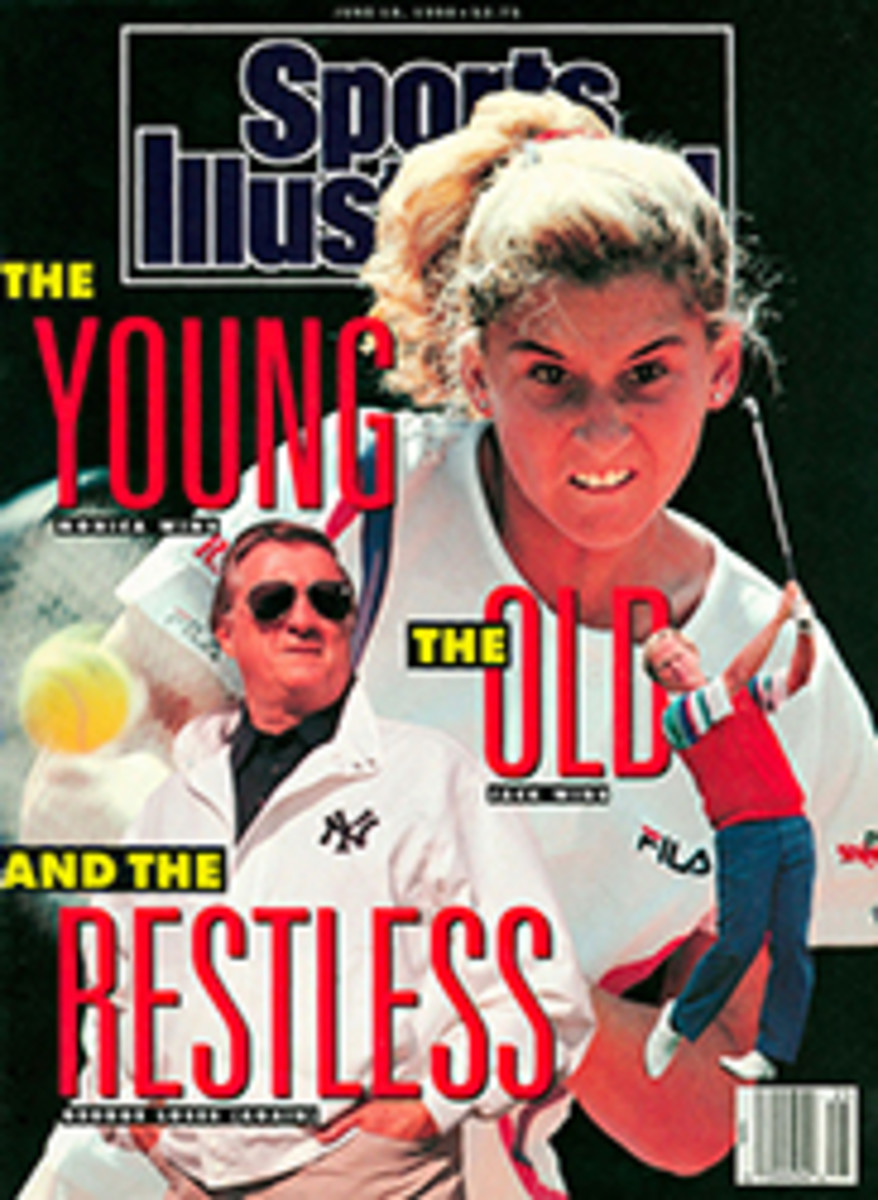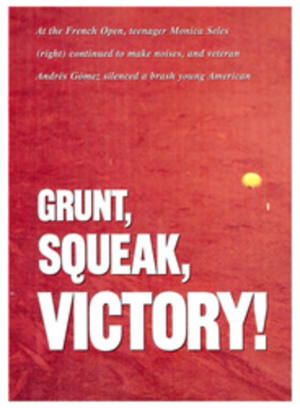
DON'T THROW OUT THAT MASHIE
With all the talk these days about a golf boom, it's worth noting that this is hardly the first time the game has ridden such a crest of popularity. Consider that in 1457 King James II of Scotland was compelled to ban the playing of golf because his subjects were spending too much time on the links instead of honing their archery skills.
The ban was largely ignored, even by the king himself, and in the five centuries since, a mountain of golf equipment, golf art, golf literature, golf trinkets and—let's face it—golf junk has been produced. Recently, much of it has been reappearing at auctions on both sides of the Atlantic. Since the early 1980s, four auctions have been held every year in Great Britain, three of them around the time of the British Open, in July, and they have been wildly successful.
The British sales have become so popular that some Americans have gotten into the game. Oliver's, a Kennebunk, Maine, auction gallery, added golf to its repertoire, and the Old Golf Shop in Cincinnati held an auction at Phillips in New York City, both in 1988. Other auctions have come on the scene since then.
Last October, the Old Golf Shop moved its sale to the Jack Nicklaus Sports Center, 20 miles north of Cincinnati. "In New York, people were spending as much money on a hotel room as they would have at the auction," said auctioneer Robert Gowland, explaining the move. Gowland, 47, a former amateur golfer from Chester, England, has been an auctioneer for Phillips of London since 1979. Though he deals primarily in Oriental rugs, Gowland ran the first all-golf auction in Britain six years ago. He marvels at the differences between chaotic, bazaar-like rug auctions and the more staid golf sales. "My staff in Great Britain are always surprised by how well behaved golf collectors are," he said.
Who are golf collectors, anyway? Kevin McGrath, of Melrose, Mass., who has been collecting since 1973, organized the first two auctions at Oliver's before holding his own in Andover, Mass., in April. "Most collectors are avid golfers who maybe didn't get as good at the game as they had hoped, and so they got into the history," he says. That might be said of Mort Olman, founder of the Old Golf Shop and co-author, with his son John, of The Encyclopedia of Golf Collectibles, a buyer's guide to memorabilia. One golf collector who probably did get as good at the game as he had hoped is Ben Crenshaw. Noted among PGA Tour players for his interest in the history of the game, Crenshaw is also on the Museum Committee of the USGA and wrote the foreword to the Olmans' book.
An amiable curmudgeon who is considered one of the world's foremost golf memorabilia experts, Olman, 74, laments the effect that auctions have had on the hobby of collecting. He is particularly disturbed by dealers who drive up prices without knowing anything about the game of golf. "When the British auctions got involved, it wrecked the whole collecting hobby," Olman complained before his own auction last fall. "People didn't know what this stuff was. The dealers should try to learn something, but they're not interested. All they're interested in is making a buck.... They love to see big prices at these auctions."
They see some very big prices, indeed. At Olman's auction, an anonymous Connecticut collector paid the world-record sum of $11,550 for a 150-year-old "feathery" golf ball, made by Allan Robertson in Scotland. Granted, it probably wasn't easy for Robertson to stuff a small leather pouch with a top hat full of wet feathers, let alone stitch the pouch up and patiently wait for it to dry before he put it to use.
The willingness to pay such high prices is based partly on the scarcity of an object. Pre-19th-century clubs are the most valuable collectors' items because there are so few of them left. But often the price of an item depends on whether it is in fashion. For instance, one piece of golf equipment, the rake iron, was rendered stylish last July at a Christie's auction in Glasgow, Scotland. The rake iron was designed for hitting out of mud or water and is considered fairly common, as uncommon clubs go. But the use of it is against the Rules of Golf, which adds considerably to its financial value. (There's hope yet for owners of nonconforming U-grooves.)
Still, knowledgeable golf collectors were stunned when an anonymous bidder offered $90,000 for an 80-year-old rake iron at the auction. In the months since, suspicion has grown about the "sale." The speculation among some collectors is that the buyer had one or two other rake irons in his attic and he wanted to drive prices up to turn a quick profit on his spring cleaning.
Whether or not the sale went through, the repercussions were felt throughout the collecting world, and rake-iron mania has yet to abate. The one rake iron at Olman's fall auction sold for $8,000, well above the anticipated price. As Gowland pointed out before the auction, "Age, rarity, condition and fashion make for high prices. At the moment, everyone thinks rake irons are fashionable. But the Ayrton is infinitely more desirable."
In Cincinnati, an Ayrton—a rare brass-headed, long-faced iron patented in 1898—went to the same buyer who snapped up the rake iron. But he got a better deal on the Ayrton, for which he paid only $5,000.
The biggest single sale at that auction was of a rare, late-18th-century iron that went to a European collector for $17,600. And the winner in the multiple-purchases category was, without a doubt, real estate developer Toshinodu Kurematsu. Shopping on behalf of his Japanese parent company—which this spring opened a golf course with a clubhouse art gallery, in the town of Narita, Japan—Kurematsu picked up at least 13 items, most of them ceramics and artwork, including a Francis Powell Hopkins watercolor, for $10,000. "We don't have a golf museum in Japan," Kurematsu said. "We want to introduce people to the history of golf."
The Japanese market is so hot that at McGrath's auction this spring, memorabilia dealer Jeff Ellis, who is also an accomplished amateur golfer, invested $15,000 in an 18-karat-gold cigarette case that Japan's Emperor Hirohito had presented to Walter Hagen when they met in Japan in 1930. The case, like 11 of the 12 other items consigned by Hagen's family to the auction, sold for a good deal less than the value estimated by McGrath. Though Ellis considered the $25,000-$50,000 catalogue estimate high for a U.S. auction, he knew that the case was "one of the earliest, truly Japanese golf items," and that if no one in Japan bid for it by mail or over the phone, he might make a good buy. Ellis opened the bidding at $10,000, and when it closed less than a minute later with his bid of $15,500, he was happy. "With the number of ways the case relates to golf and Japan—Hagen, Hirohito, the inscription—it could be a $50,000 item in downtown Tokyo," Ellis said.
Most golf collectors have less lofty goals. Among the more modest shoppers at the Ohio auction was Richard Dinely, a Washington, D.C., investment banker who has played the game for 30 years and has a 15 handicap. Dinely collects original golf artwork and cigarette cards that feature photographs of prominent golfers and once came in cigarette packages. Already the owner of five sets of cards, Dinely picked up another five, most of them partials to be used to complete other sets.
As Gowland said before the auction, "There are about 4,000 collectors in the world, and most get a lot of pleasure from inexpensive things. The more serious collectors number around 1,500. Only about 100 people will pay more than $2,000 for an item."
To the uninitiated, collecting golf memorabilia may seem pretty tame. But there is a good deal of historical insight to be gained in rummaging through boxes of old items. "I found a book published in 1892 called Golf in the Year 2000," said Olman. "The guy predicted you'd be able to look on your wall and see a match played between England and Scotland.... That's TV!"
Who knows how many billions of yen someone will pay for a Surlyn-covered Titleist at the annual Narita Golf and Country Club auction in the year 2090?
FIVE PHOTOS
TONY TOMSIC
Collectibles from a recent auction include (clockwise, from upper left) a silver statue; a Dunlop figurine; a rake iron, which fetched $8,000; sheet music; and cigarette cards.
PHOTO
TONY TOMSIC
Mort Olman and his son John have held two of their own auctions.

